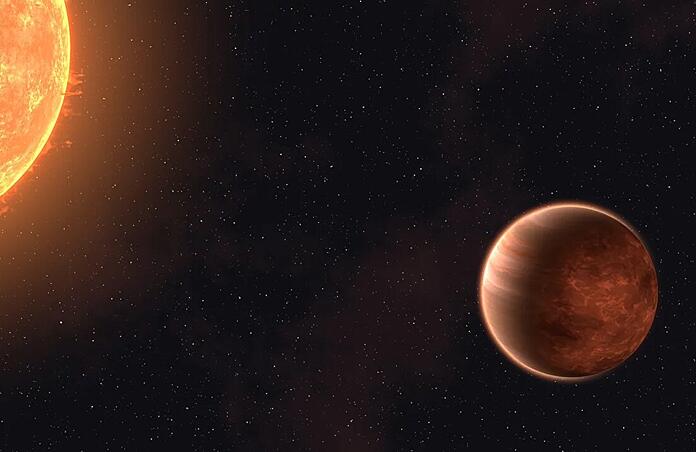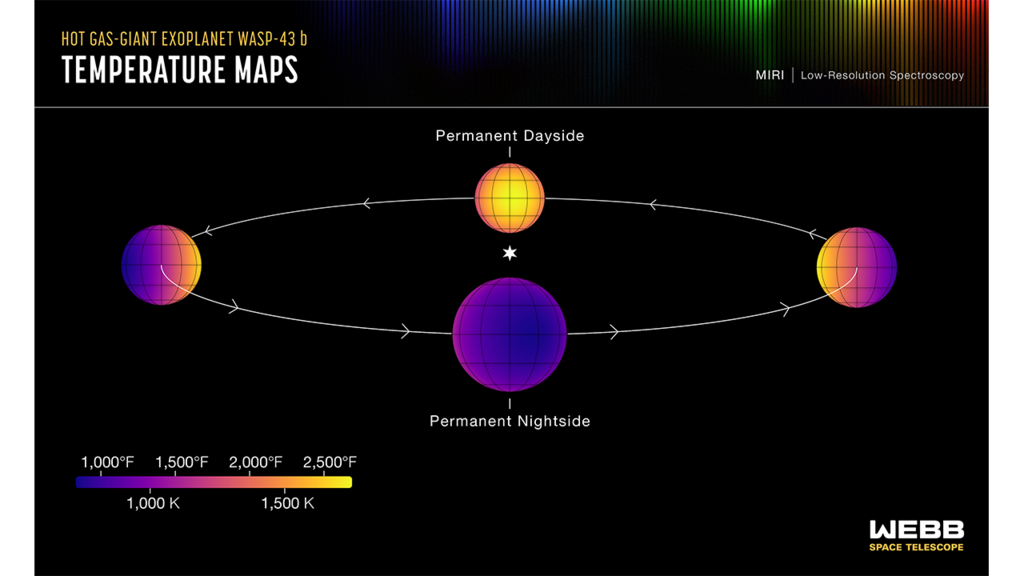Temperature map of WASP-43b constructed using JWST

With the use of the James Webb Space Telescope (JWST), a global temperature map of hot Jupiter WASP-43b has been constructed by a team of astronomers. The map reveals information about the day and night sides of the planet, and their vast environmental differences.
Hot Jupiters are a class of gas giants physically similar to Jupiter but possess much shorter orbital periods of less than 10 days. The close orbits of these exoplanets to their host stars can lead to a range of intriguing properties concerning temperature, density, composition, chemistry and weather. With the launch of JWST, the atmospheres of such planets can be studied in more detail than before. The hot Jupter WASP-43b has an extremely fast orbital period of 19.5 hours. Due to the close distance of the orbit, the planets orbit is synchronised with the host stars rotation – in other words, WASP-43b is tidally locked. Therefore, the same hemisphere always faces the star, resulting in a permanent dayside and nightside.

WASP-43b was observed using JWST’s Mid Infrared Instrument (MIRI) with the aim of studying its climate. Light from the system was observed every 10 seconds for over 24 hours. "By observing over an entire orbit, we were able to calculate the temperature of different sides of the planet as they rotate into view," explained Taylor J. Bell, who led the study published in Nature Astronomy. "From that, we could construct a rough map of temperature across the planet." The observation was made by the JWST Transiting Exoplanet Early Release Science (JTEC-ERS) team, who are an international collaboration of astronomers.

The main findings from the observations are a map demonstrating the global temperature distribution derived from the infrared light WASP-43b emits in response to the irradiation by the host star. MIRI works in a way similar to a non-contact thermometer except across much larger scales, since the wavelength range it observes is sensitive to warm materials. From the map, the measured temperature ranges between 600 and 1250C, highlighting the differences between the nightside and dayside. In addition, the hottest spot on the planet was found to be shifted slightly eastward from the point that receives the most stellar radiation. This shift happens due to supersonic winds, moving the heated air eastwards.
It was also found that WASP-43b hosts violent winds, which carry air from one hemisphere to the other at rapid speeds of nearly 9000kph. This is faster than anything we find in our solar system. "With Hubble, we could clearly see that there is water vapor on the dayside. Both Hubble and Spitzer suggested there might be clouds on the nightside," explained Bell. "But we needed more precise measurements from JWST to really begin mapping the temperature, cloud cover, winds, and more detailed atmospheric composition all the way around the planet."
The observations uncovered that the dayside-nightside temperature contrast was larger than what we expect for a cloud-free atmosphere. Along with 3D climate models, it was confirmed that the nightside is blanketed in a thick layer of clouds high up in the atmosphere, blocking much of the infrared radiation from below we would see. However, the type of clouds is still unknown- they will not be water clouds like that on earth or ammonia clouds on Jupiter since the planet is too hot for water and ammonia to condense. It is expected that the clouds are comprised of rocks and minerals as liquid rock droplets. On the dayside, no clouds were seen.
To further probe the atmospheric composition, the team produced spectra by breaking up the infrared signal into small wavelength bins. Spectra allows astronomers to identify the presence of various chemical substances which have signatures at specific wavelengths. From this, they confirmed earlier measurements of water vapour made by Hubble, except now this can be seen over the entire planet. Previous Hubble observations could only study the dayside, since the nightside was too dark.
Hot Jupiters usually host large amounts of molecular hydrogen and carbon monoxide, however neither could be probed by the JWST observations. Nonetheless, concerning the nightside, hydrogen and carbon monoxide are involved in a group of chemical reactions that produce methane and water. MIRI did not detect any methane. This surprising result can be explained by the rapid winds on WASP-43b – molecules involved in the reactions pass the cooler nightside so quickly that there isn’t enough time for the reactions to produce detectable amounts of methane. Any small amount of methane becomes mixed with other gases, which quickly reach the dayside again whereby they are destroyed from extreme heat.
"With the new observing power of JWST, WASP-43b has been unveiled in unprecedented detail," said Laura Kreidberg, Director at the Max Planck Institute for Astronomy (MPIA) in Heidelberg, Germany. She is a co-author of the underlying research article and has been exploring the planet for a decade.
"We see a complex, inhospitable world, with furious winds, massive temperature changes, and patchy clouds likely made of rock droplets. WASP-43b is a reminder of the vast range of climates that are possible on exoplanets and the many ways in which Earth is special."
Another team led by former MPIA scientist Stephan Birkmann (European Space Agency) is conducting a follow up survey. They will look into WASP-43b with JWST’s Near-Infrared Spectrometer (NIRSpec). Such measurements will be sensitive to carbon monoxide gas that should be present throughout the planet’s atmosphere. Additionally, the larger wavelength coverage will improve the temperature map, helping to investigate the cloud distribution and composition more precisely.
--
Cover image: T. Müller (MPIA/HdA)
Journal source: Taylor J. Bell et al, Nightside clouds and disequilibrium chemistry on the hot Jupiter WASP-43b, Nature Astronomy (2024). DOI: 10.1038/s41550-024-02230-x
